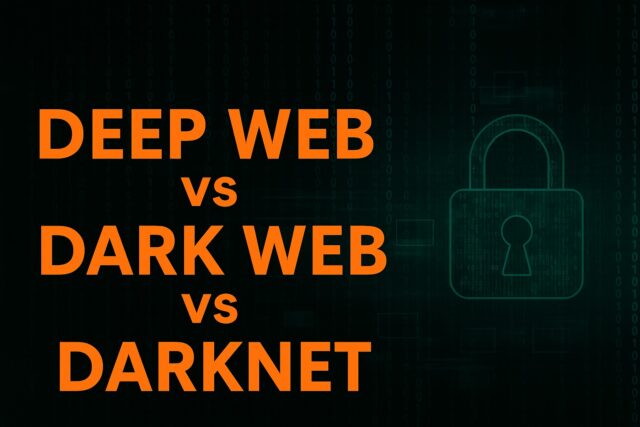Introduction: How Much of the Internet Can You See?
You’re only scratching the surface when you use the Internet for daily activities—reading news, managing finances, running businesses. Search engines like Google, Bing, and Yahoo can access just about 4% of the web.

What about the other 96%?
That hidden portion lives across the Deep Web, Dark Web, and Darknet. These terms are often confused or misused, but they describe very different layers of the Internet.
In this guide, we’ll break down:
The real difference between Deep Web, Dark Web, and Darknet
How can you safely access them while maintaining anonymity
Common myths vs. real-world use cases
How each works and what they’re used for
Surface Web vs Deep Web vs Dark Web vs Darknet
Picture the Internet like an iceberg. The small visible tip is the Surface Web—everything easily searchable. Beneath it lies the vast hidden layers: Deep Web, Darknet, and Dark Web.
| Layer | Description | Access Method | Example Content |
|---|---|---|---|
| Surface Web | Public websites indexed by search engines | Normal browsers (Chrome, Firefox) | News, YouTube, Amazon |
| Deep Web | Pages hidden from search engines, but still public | Direct URL or login | Email inboxes, academic databases |
| Darknet | Encrypted networks requiring special software | Tor, I2P, Freenet | Anonymous forums, hidden services |
| Dark Web | Content hosted within Darknets | Tor browser | Black markets, political blogs, whistleblower sites |
(Source: CSO Online)
The Surface Web is the portion of the Internet you access daily:
- Social media (Facebook, Twitter)
- News websites
- Online banking portals
- E-commerce platforms like Amazon
Standard search engines index these websites and are accessible without special configuration.
There are estimated to be 1.1 billion websites on the Surface Web as of 2025 (Internet Live Stats).
The Deep Web includes all content not indexed by search engines.
This isn’t necessarily illegal—it’s just private or restricted.
Examples:
- Private email accounts (e.g., Gmail inboxes)
- Medical records portals
- Academic research libraries behind paywalls
- Corporate intranets and document management systems
Access often requires login credentials, but does not require special software.
Even platforms like Netflix, which require paid access, are technically part of the Deep Web.
The Darknet is a subset of the Internet operating over encrypted, anonymous overlay networks that require special software like Tor, Freenet, or I2P.
Unlike the Deep Web, Darknets are intentionally hidden and designed to preserve privacy and anonymity.
Key Darknet technologies:
- Tor (The Onion Router)
- I2P (Invisible Internet Project)
- Freenet
Example use cases:
- Secure whistleblowing (e.g., via SecureDrop)
- Accessing news in countries with heavy Internet censorship
- Hosting sensitive communication channels
The Dark Web refers specifically to websites and services hosted inside Darknets. Search engines do not index these sites and use domains like .onion (for Tor) or .i2p (for I2P).
Examples of Dark Web activity:
- Whistleblower platforms (e.g., SecureDrop)
- Cryptocurrency trading hubs
- Political activism blogs
- Unfortunately, also black markets and illegal activities
Important:
Simply accessing the Dark Web is not illegal. Engaging in illegal activities (like buying drugs, weapons, or stolen data) is illegal.
(Source: FBI Public Awareness)
If you choose to explore, follow strict privacy protocols:
- Use a reliable VPN: Mask your IP address before anything else.
- Download Tor Browser only from the official site.
- Close all non-essential programs before connecting.
- Access .onion sites directly via Tor.
- Never use personal information (name, email, photos) while browsing.
- Disable scripts, adjust security settings inside Tor Browser.
Additional security steps:
- Cover webcams and microphones
- Avoid resizing browser windows (helps prevent fingerprinting)
No, it is not illegal to access the Dark Web or use Tor.
However, accessing illegal content (e.g., child exploitation material, drug markets) is a crime.
Countries differ in how aggressively they monitor Dark Web activity. In some authoritarian states, accessing Tor nodes can flag you for surveillance.
(Source: Electronic Frontier Foundation (EFF) Guide)
- Circumventing censorship in authoritarian countries
- Protecting whistleblower identities
- Researching cybersecurity threats (legally)
- Private communications
- Investigating personal data leaks
Darknet tools have real value in privacy-focused, humanitarian, and journalistic efforts.
- DuckDuckGo: Private search engine accessible via Tor
- Torch: A long-standing Dark Web search engine
- TorLinks: Directory of onion services
(Note: Access these links only via Tor Browser.)
The Darknet is a tool. Like any tool, it can be used for both legitimate and illicit purposes.
The Dark Web and Darknets offer valuable spaces if you value privacy, freedom of speech, or research security technologies.
If you misuse them, the consequences can be severe.
Knowledge is power—and protection.
Stay safe, stay smart, and stay informed.
